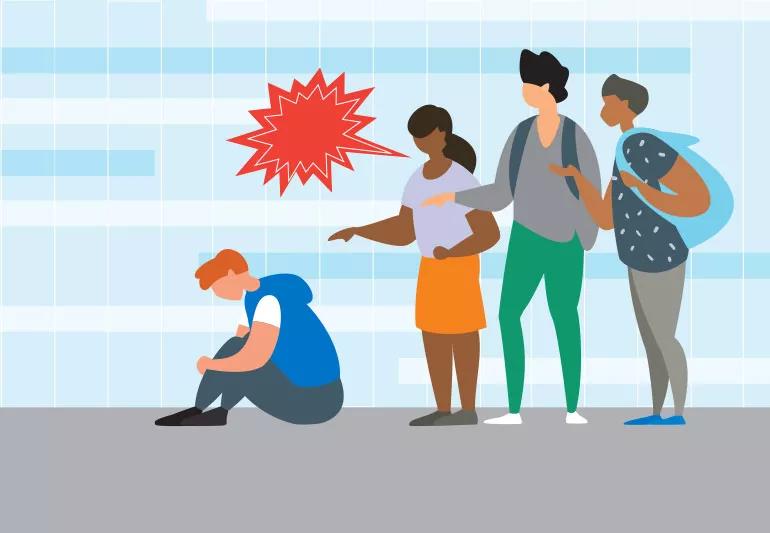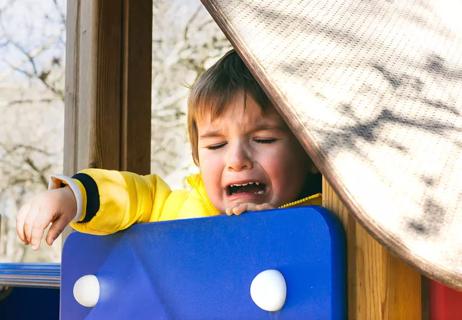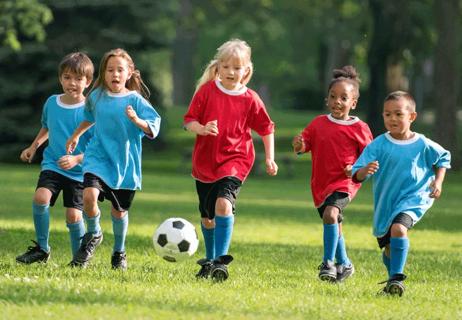It starts with teaching your child how to use emotional language and to respect others

If you have children, there are many things that can worry you day-to-day about their growth and development.
Cleveland Clinic is a non-profit academic medical center. Advertising on our site helps support our mission. We do not endorse non-Cleveland Clinic products or services. Policy
For example, you may be concerned about what they’re eating, what they’re learning in school and if they’re making enough friends.
And you’re probably worried about how others are treating them: Are they getting bullied?
So, it may surprise you if you get feedback from another parent or a teacher that your child is the bully — and that they’ve been unkind to another child.
While it can be stressful to hear that your child is the source of someone else’s unhappiness, there are steps you can take to raise an empathic and kind person.
“It’s important to teach kids that if there’s a problem with getting along with other people that it’s considered bullying,” explains pediatric psychologist Amy Lee, PhD. “And when you see bullying behavior, as a parent, you need to make sure it’s corrected and stopped.”
Dr. Lee shares a few ways you can encourage open, assertive communication with your child, and explains how to stop bullying.
In recent years, the word “bullying” has become a more common way to describe how someone treats another in a negative way.
Dr. Lee defines it as “repeated aggressive behavior directed at a person or a group in order to exert power over that person or group.”
This can include controlling, harassing and intimidating others.
When you think of a bully, chances are, you’re picturing a child who can overwhelm others with their size on the school’s playground. But in fact, anyone is capable of being a bully, regardless of their sex, gender, race, age or size.
And bullying can happen anywhere — from gym class to online. Cyberbullying tends to happen in secret and can be harder to detect.
“I think one thing for parents to understand is that kids can be bullies and bullied — all at the same time,” clarifies Dr. Lee. “While bullying has to do with power, a child may have insecurity about something else and use bullying as a way to feel important and noticed.”
And if your child is being a bully, it’s important to realize that you don’t have a bad kid — your child may just be using bullying as a strategy to manage a situation or protect themselves.
So, when should you start talking to your child about bullying? Dr. Lee says to lay the foundation early by teaching your child some fundamental skills — as early as preschool when your child starts forming friendships with others.
“As they get older, you want to start teaching your child about intention,” says Dr. Lee. “You need to have repeated conversations — it’s an ongoing process of teaching them about social and emotion self-control.”
Here are a few things you can do.
You’ve probably talked to your child about respecting adults, but make sure it’s clear to them that they need to respect everyone, including children, and that they need to treat them with kindness.
“Children naturally seek attachment to their caregivers. We teach about kindness in every interaction with our children,” notes Dr. Lee. “Labeling their behaviors and actions as kind, helpful and gentle are all good ways to reinforce kindness and respect.”
Learning from an early age that we all have emotions can help your child practice how to communicate with others and understand how others may be feeling.
“Label emotions to help kids identify what they’re feeling when something happens. For example, you can say, ‘That makes you so mad. I know you don’t like it when Mommy takes your toy away.’ We should also label positive emotional experiences like “I feel good when you hug me,” or “We feel happy when we play together,’” relays Dr. Lee. “It also helps kids understand that other people have emotional states.”
“Pay lots of attention to expected or positive behaviors. ‘Thank you for being helpful. Thank you for listening,’” advises Dr. Lee. “When a parent comes in and tells me, ‘My 5-year-old is defiant and never listens,’ the first thing we teach them is positive attention.”
She adds that for every correction or punishment you give, aim for five to 10 instances of telling them what they did right. Positive attention is much more powerful for shaping behavior than negative attention, punishment or corrections.
Your child isn’t a perfect angel 24/7, so in those moments where they might have a meltdown, argue or lash out at others, Dr. Lee says don’t give excessive attention to the negative behavior.
“Use timeouts as a way to calm down. Take away all attention, and give your child time to pull it together,” she advises. “Remove the child and the object causing conflict from the situation immediately without a lot of talk. Once things settle down, you can problem-solve.”
Let’s say your child repeatedly hits his younger brother. You’ve repeatedly corrected the behavior, but it continues. Do some problem-solving together to find out why.
“You might say, ‘You keep hitting your brother. What’s up?’ By doing this, you teach your kid to name the problem, and you get their perspective,“ Dr. Lee explains. “Then, armed with the full picture — maybe the younger brother is wrecking his brother’s toys — you can come up with a solution together.”
Pay attention to your child’s circle of friends. We’re not saying to eavesdrop into their conversations, but observe how they all interact with each other. If it’s your turn to carpool, those backseat conversations can help you glean a lot about the dynamics within the group.
“Parents are children’s first teachers,” notes Dr. Lee. “Parents can continue to teach about caring for one another by being positive role models with their kid’s friends, too.”
Is it ever OK for your child to hit back? The short answer is no.
“Aggressive behavior is aggressive behavior even if somebody hurt you first,” states Dr. Lee. “Aggression may seem like a solution in the short run but can eventually lead to much bigger problems in life. Society rewards self-control and assertiveness.”
So, while there may be a culture of verbal aggression in some of your child’s relationships, it’s important for them to learn how to manage themselves in ways that don’t perpetuate these negative behavior patterns with others. Dr. Lee provides a few examples:
But what if your kid is already a teenager and you feel like they may be bullying others? It’s never too late to start implementing these strategies. And there are plenty of resources to help you teach it.
“School counselors, law enforcement, mental health professionals and pediatricians are all well-armed with strategies to help parents and kids — no matter the situation,” encourages Dr. Lee.
Learn more about our editorial process.

Like a boring ol’ grey rock, the goal is to be unresponsive and uninteresting to dissuade a harmful situation

Narcissistic personality disorder is a mental health condition, not an insult

Whether this behavior is abusive depends on the person doing it and their motivation

Too much screen time and unrealistic expectations and perceptions and can lead to an increased risk of anxiety and depression

They’re nontoxic, but crayons can cause an upset stomach and pose a serious choking hazard

From split lips to splinters, a little first-aid can get your kiddo back on the swing set in no time

Participating in sports teaches kids life skills and can build self-confidence for the long haul

Dietary and behavioral changes can help get things moving again

Your metabolism may torch 1,300 to 2,000 calories daily with no activity

A gentle touch in all the right places may help drain your sinuses